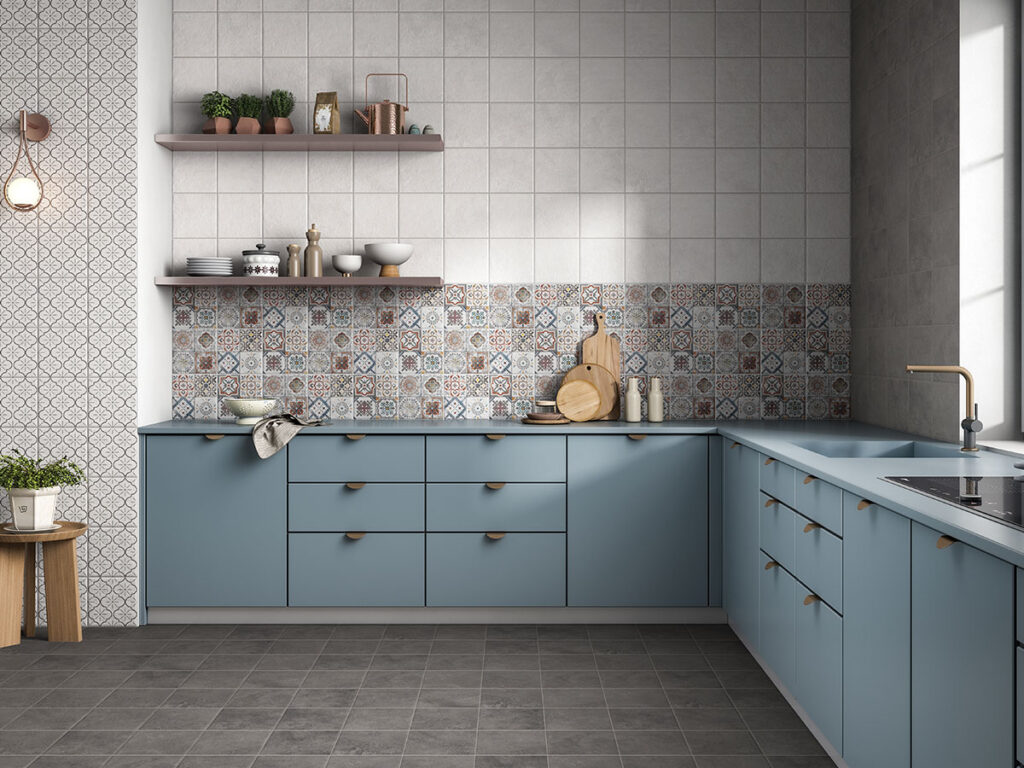Table of Contents

Know Everything About Kitchen Floor
When it comes to designing your dream kitchen, choosing the right flooring is a critical decision. Kitchen floors endure a lot of wear and tear, from spills and stains to heavy foot traffic. This is where kitchen floor tiles come into play. Not only do they need to be durable and functional, but they also play a significant role in enhancing the overall aesthetics of your kitchen. In this article, we will explore various aspects of kitchen floor tile design, including materials, patterns, colors, and installation tips.
To Read More Click Here
Tile Materials: Durability and Style
The first step in designing your kitchen floor is selecting the right tile material. Each material has its unique advantages and can dramatically impact the look and feel of your kitchen.
Ceramic Tiles
Ceramic tiles are a popular choice for kitchen floors due to their durability, affordability, and wide range of design options. They are resistant to moisture, stains, and scratches, making them ideal for a busy kitchen. Ceramic tiles are available in various colors, patterns, and sizes, allowing you to create the perfect look for your space.
Porcelain Tiles
Porcelain tiles are a type of ceramic tile known for their exceptional durability and low maintenance. They are highly resistant to moisture and can withstand heavy traffic, making them an excellent choice for kitchen floors. Porcelain tiles come in various finishes, including matte, glossy, and textured, offering versatility in design.
Natural Stone Tiles
If you’re looking for a luxurious and timeless look, natural stone tiles like marble, granite, and travertine are excellent options. These materials add a touch of elegance and sophistication to your kitchen. Keep in mind that natural stone requires more maintenance and may be susceptible to stains, so proper sealing is essential.
Vinyl Tiles
Vinyl tiles have come a long way in terms of design and durability. They are affordable, easy to install, and available in a wide range of patterns and colors, including styles that mimic natural stone or wood. Vinyl tiles are water-resistant, making them a practical choice for kitchens.
Choosing the Right Color and Pattern
Once you’ve decided on the material, it’s time to consider the color and pattern of your kitchen floor tiles. This decision can significantly impact the overall aesthetics of your kitchen.
Light vs. Dark Colors
Light-colored tiles can make your kitchen appear more spacious and airy. They also tend to show fewer stains and dirt. On the other hand, dark-colored tiles can add warmth and coziness to the space but may require more maintenance to keep them looking clean.
Patterns
The choice of tile pattern can transform the look of your kitchen. Consider options like subway tiles for a classic, timeless look, herringbone patterns for a touch of elegance, or mosaic tiles for a pop of color and texture. The pattern you choose should complement your kitchen’s style and your personal preferences.
Tile Size
The size of the tiles you select can also influence the perception of space. Larger tiles can create a sense of continuity and make a small kitchen appear more expansive. Conversely, smaller tiles can add intricate details and visual interest to the floor.
Practical Considerations
Apart from aesthetics, there are practical considerations when designing your kitchen floor with tiles.
Slip Resistance
Kitchen floors can get slippery, especially when wet. To ensure safety, opt for tiles with a slip-resistant surface or finish. This is particularly important if you have children or elderly individuals in your household.
Maintenance
Consider the level of maintenance you are willing to commit to. Some tiles, like natural stone, may require regular sealing and maintenance to prevent stains and damage. Others, like ceramic and porcelain, are relatively low-maintenance.
Grout Color
The color of the grout between the tiles can impact the overall look. Light-colored grout can blend in and create a seamless appearance, while contrasting grout can define the individual tiles. Keep in mind that lighter grout may require more frequent cleaning to maintain its appearance.
Installation Tips
Proper installation is crucial to ensuring the longevity and functionality of your kitchen floor tiles. It’s often best to hire a professional for the job, but here are some essential installation tips:
Subfloor Preparation
Ensure that the subfloor is clean, level, and dry before installing tiles. Any irregularities in the subfloor can lead to tile cracks or uneven surfaces.
Tile Spacing
Use tile spacers to maintain consistent spacing between tiles. The size of the spacers depends on the desired grout line width.
Grout Sealing
After the tiles are installed and the grout has cured, it’s essential to seal the grout to protect it from stains and moisture.
Expansion Joints
Incorporate expansion joints around the perimeter of the room and at transitions to other flooring materials to prevent cracking.
In conclusion
selecting the right kitchen floor tiles involves a balance between aesthetics and functionality. Consider the material, color, pattern, and practical aspects to create a kitchen floor that not only looks stunning but also withstands the demands of daily life. With the right choices and proper installation, your kitchen floor tiles can be a durable and stylish addition to your home.
Remember that it’s always a good idea to consult with a professional or seek advice from a tile specialist when making your final decisions. Your kitchen is the heart of your home, and investing in high-quality floor tiles will pay off in the long run, both in terms of functionality and visual appeal.
Looking for Digital Marketing Service Click Here
